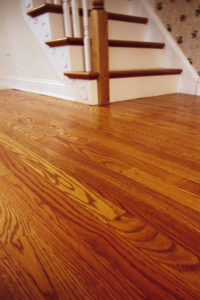Hardwood restoration is often required when the finish that protects wood flooring erodes from constant wear and tear. Usually, the most cost-effective and most popular restoration method is to scuff and buff. Because hardwood is a valuable investment, it’s important to keep it in good condition, but it’s also just as important to have it restored properly.
A professional can come to your home to lightly scuff the flooring without creating too much dust. The contractor will then recoat the floor with a new finish, which typically takes 1 to 3 days to dry. If performed at the right time, this process is a good alternative to sanding.
However, sanding is sometimes unavoidable in hardwood restoration. If the floor has worn down to the wood (drip some water on it and see if it’s quickly absorbed), or if it’s bent or warped, or if it squeaks, it may need to be completely sanded and refinished. This may be more expensive and dustier, but, again, it’s worth every dollar to protect your investment.
Tongue-and groove floors cannot be sanded and refinished as often as planks can, but the planks must be a certain thickness. Floors that are not thick enough are at risk of losing too much surface if sanded. In this case, replacement may be needed.
But don’t worry; most of the time, it’s not necessary to replace the entire floor. A trained hardwood restoration contractor is able to change out specific areas, providing the damage is contained. What about repairs? Yes, a trained contractor is also able to remove spots, small stains and blemishes without having to work on the entire floor.


